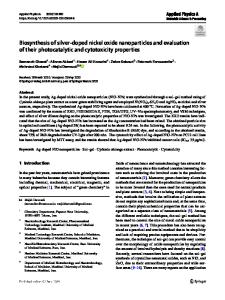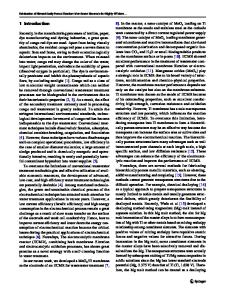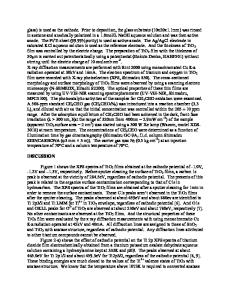The fabrication of hierarchically porous carbon-coated nickel oxide nanomaterials with enhanced electrochemical properti
- PDF / 2,959,836 Bytes
- 13 Pages / 595.276 x 790.866 pts Page_size
- 48 Downloads / 311 Views
The fabrication of hierarchically porous carbon-coated nickel oxide nanomaterials with enhanced electrochemical properties Chao Sun1, Hongzhe Sun1, Zhiguang Guo1, and Fengyan Ge1,* 1
Key Lab of Science & Technology of Eco-Textile, Ministry of Education, College of Chemistry, Chemical Engineering and Biotechnology, Donghua University, Shanghai 201620, China
Received: 1 June 2020
ABSTRACT
Accepted: 30 September 2020
In our current work, hierarchically porous carbon-coated nickel oxide nanoplates were successfully synthesized through Ni(OH)2 cladding with resorcinol and formaldehyde resin after subsequent carbonization process. The as-prepared NiO-coated carbon nanomaterials were examined, using TEM, XRD, Raman, XPS, TG and BET measurements. The optimized electrode (NiO/Ni@C450 nanoplates) has regular hexagonal core–shell structure, uniform diameter and thickness. Owing to its porous core–shell structure, high specific surface area (457.03 m2 g-1) and high contents of Ni (6.43 at.%) and O (19.35 at.%) elements, NiO/Ni@C-450 electrode possesses the specific capacitance of 276.1 F/g at 0.5 A/g and good coulombic efficiency. Because the coated carbon layer enables to protect NiO structure and extends the cyclic life of electrode materials, the capacitance retention of NiO/Ni@C-450 electrode is 88.7% after 1000 cycles, which is much higher than that of NiO electrode. All these measured results demonstrate that the as-prepared NiO/Ni@C-450 nanoplate is supposed to be a promising material with easy preparation, high specific capacitance and good cyclic stability properties for potential applications in energy storage devices.
Ó
Springer Science+Business
Media, LLC, part of Springer Nature 2020
1 Introduction Supercapacitors have attracted enormous attention, because of its rapid charge–discharge capability, long-term cyclic life and high power density, and they are widely recognized as the most prospective technology for sustainable energy storage [1–3]. Supercapacitors usually consist of electrodes,
Address correspondence to E-mail: [email protected]
https://doi.org/10.1007/s10854-020-04585-z
electrolytes, collectors and packing materials, in which, electrodes determine its electrochemical performances [4–6]. According to the different mechanisms of charge storage, typical electrode materials mainly including electrical double layer capacitances (EDLCs) such as various carbon materials and pseudocapacitive storage materials which contain transition metals oxides/hydroxides and conductive
J Mater Sci: Mater Electron
polymers [7, 8]. Compared to the EDLCs which store energy only through adsorption–desorption of ions at the surface of electrode materials, pseudocapacitors have got much more attention as their can make use of rapid reversible surface or near surface redox reactions to offer 3 or 4 times higher capacitance [9, 10]. However, an ideal electrochemical electrode material for practical applications should have high electrochemical capacity and cyclic stability, largescale processible material form (powd
Data Loading...











